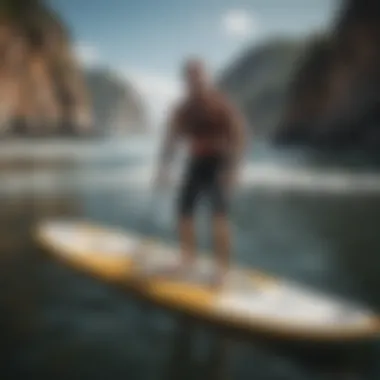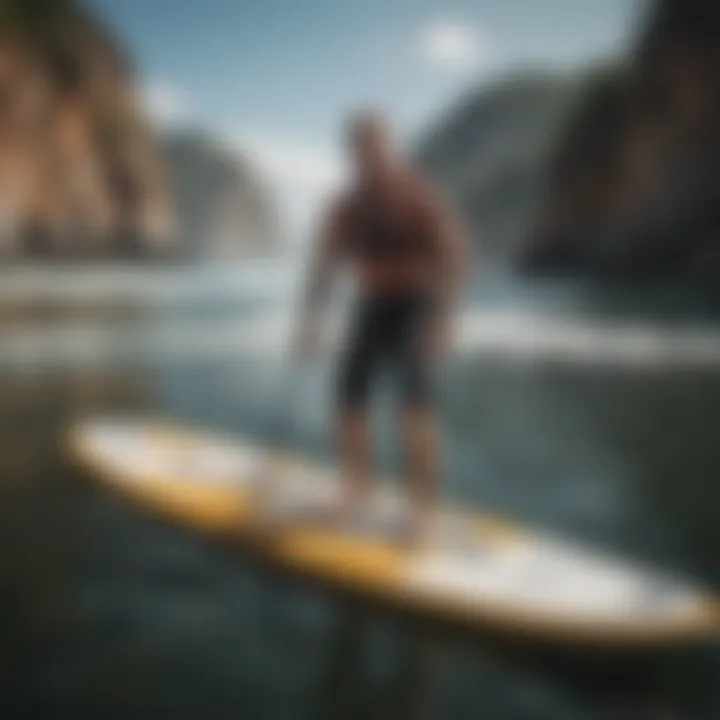Wing Surfing and Stand-Up Paddleboarding Explained


Intro
Wing surfing and stand-up paddleboarding (SUP) are two thrilling water sports that have captured the imaginations of adventure seekers worldwide. Both activities involve a unique blend of skill, balance, and an appreciation for nature’s elements. At first glance, one might wonder how these two sports can fit together, but they share a commonality that enhances the experience for enthusiasts. With the rising popularity of wing surfing, paddlers are starting to explore how to incorporate wings with their SUP boards, creating a unique synergy that enhances both sports.
This guide seeks to delve deep into the marriage of wing surfing and the stand-up paddleboard, emphasizing key equipment, essential techniques, safety guidelines, and travel destinations that suit both novices and seasoned practitioners. Here, we will cover all bases, ensuring every detail paints a clear picture for those venturing into this exciting watersport landscape.
Through this exploration, we aim to provide practical insights, demystifying gear specifications, environmental factors affecting performance, and the vibrant culture that wraps around these activities. From the bustling beaches of Hawaii to the quiet coves along the Mediterranean, we’ll also spotlight the most engaging locations to test your skills and have a grand adventure.
At the heart of this journey is the equipment—an important element that can drastically affect performance. The subcultures of both wing surfing and stand-up paddleboarding draw people together, sharing techniques and safety practices that ensure everyone has a great time on the water.
As we navigate through gear reviews, safety guidelines, and the thrill of discovering new locations, we hope readers develop a deeper understanding of how wing surfing and stand-up paddleboarding can complement each other, opening the door to endless possibilities on the water.
Intro to Wing Surfing and Stand-Up Paddleboarding
Wing surfing and stand-up paddleboarding (SUP) have become synonymous with a modern approach to water sports. These two activities, though distinct in their techniques and equipment, share an energetic synergy that captivates both enthusiasts and casual water-goers alike. Understanding how they interconnect can enhance your experience on the water, whether you're a seasoned athlete or a newcomer.
Wing surfing combines the thrill of wind power with the luxury of maneuvering a paddleboard. The essential appeal lies in its adaptability. With a wing in hand, one can harness the wind to glide across the water, making it accessible in varying conditions—whether you’re in a mild breeze or a more robust gust. On the other hand, stand-up paddleboarding provides an excellent foundation for balance and technique, skills that are invaluable when piloting a wing. This article explores how these two water sports complement one another and the advantages they offer to practitioners.
Understanding the Basics
Before taking the plunge into wing surfing or stand-up paddleboarding, it’s crucial to grasp some fundamental concepts. Wing surfing utilizes a canvas wing that catches the wind, which is attached to the rider on what is usually a larger paddleboard. This setup allows the rider to propel forward without a conventional harness. On the flip side, stand-up paddleboarding involves standing upright on a board while using a paddle to propel oneself through the water. The key takeaway here is the mechanics of movement and maintaining balance.
A significant advantage of SUP is that it enhances your core strength and stability, elements essential for controlling a wing. Practicing on a paddleboard allows riders to develop an intuition for the water, wind conditions, and overall awareness. Moreover, both activities emphasize the importance of reading the environment—be it river swells, ocean waves, or gusty winds.
Historical Context of Each Sport
Wing surfing and stand-up paddleboarding have origins that, while different, reflect a similar spirit of adventure and innovation. Stand-up paddleboarding traces its roots back to ancient Polynesians, who navigated their islands on wooden boards while paddling—thus marking the sport’s rich history as a practical means of transport. It wasn’t until the late 20th century that SUP found its way into mainstream watersports, gaining traction worldwide, especially in the fitness and relaxation arenas.
In stark contrast, wing surfing is a relatively modern phenomenon. Though variations of windsurfing have been around for decades, the wing design, which gained popularity in the early 2010s, quickly captured water sports enthusiasts. Riders saw the potential for a more maneuverable and lighter alternative, thus blending elements of kiteboarding and windsurfing. As such, both sports have carved distinct paths in the water adventure space, yet their collision creates a rich, evolving culture of challenges and possibilities.
"The marriage of wing surfing and paddleboarding unlocks a playground for water sports enthusiasts. Each provides foundational skills that enrich the other, enabling endless possibilities on the water."
As you paddle through the nuances of each discipline, keep in mind that both sports invite exploration and growth. They are more than just leisure activities; they are vivid expressions of connection with nature and fellow adventurers.
The Mechanics of Wing Surfing
Understanding the mechanics of wing surfing is crucial, as it serves as the backbone for all successful maneuvers and techniques in this spirited water sport. Unlike traditional surfing or even windsurfing, wing surfing combines the buoyancy and stability of a stand-up paddleboard with the freedom and maneuverability afforded by the inflatable wing. This section delves deep into how these two components work in harmony, allowing for a unique experience on the water that appeals to both novices and seasoned enthusiasts alike.
How Wing Surfing Works
At its core, wing surfing requires the rider to harness wind power using a handheld wing while gliding across the waters on a paddleboard. The wing inflates with wind and gives lift, while the board floats buoyantly atop the surface. Getting started involves a few steps: positioning the board, securing the wing, and using the wind effectively. As a rider, you must catch the wind in your wing, which generates forward momentum.
The essential aspect of wing surfing is understanding that the wind direction can change rapidly. Riders frequently adjust their stance and grip on the wing to maximize the wind power at their disposal. By shifting weight and changing the angle of the wing, it's possible to maneuver in various ways, whether it's cruising, turning, or performing tricks.
Controlling the Wing
Controlling the wing effectively can feel like taming a wild stallion—one small misstep can send you sailing in the wrong direction! It all starts with the grip. The wing comes with handles that allow you to manipulate it easily. Understanding how to position your hands on those handles is vital for gaining control.
The key to mastery is practicing the action of sheeting in and out, which refers to adjusting how much you pull the wing towards your body (sheeting in) or releasing it (sheeting out). Here are some tips:
- Stay Relaxed: Maintain loose arms and shoulders; it’s tempting to tense up when the wind kicks in, but relaxation is crucial.
- Foot Positioning: Shift your foot stance to remain balanced while adjusting wing control. A slight change in foot position can alter your center of gravity significantly.
- Look Ahead: Focus on where you plan to go rather than your current position; this helps in planning your next move.
Wind Dynamics and Performance
Every savvy rider knows that wind dynamics play a pivotal role in wing surfing. Understanding not only the speed but also the quality of the wind can make or break your ride. For instance, steady, consistent winds allow you to catch waves gracefully, while gusty winds can cause abrupt changes in speed and direction.
Optimizing your performance demands keeping an eye on wind conditions before setting sail. Here are a few factors to consider:
- Wind Speed: Too little wind means sluggish movement, while too much can lead to difficulty in control. Finding that sweet spot is essential.
- Slalom Tactics: Learn to zigzag across varying wind patterns which enhances speed and allows for more advanced tricks.
- Choosing the Right Wing Size: Depending on conditions, you might need a bigger wing for light winds and a smaller one for stronger gales. Choosing the appropriate size affects overall performance.
"Mastering the elements of wind and water is the lifeblood of wing surfing success."
Choosing the Right Equipment
Selecting the right equipment is crucial in wing surfing with stand-up paddleboards, as it significantly impacts your experience on the water. The right gear can not only enhance your performance but can also ensure your safety, particularly for those just starting out. Each element of your equipment contributes to how well you can maneuver, control your speed, and respond to changing wind conditions.


Types of Wings Available
When it comes to wings, there's a variety to choose from, each designed to cater to different preferences and skill levels. The wings can differ in size, shape, and material, impacting how they perform in various wind conditions.
- Inflatable Wings: Generally more user-friendly for beginners, inflatable wings offer a balance of weight and stability. They are easier to handle on the water, making them ideal for newcomers.
- Rigid Wings: These wings provide greater performance in strong winds. They are stiffer and more responsive, however, they can be trickier to use due to their unique handling.
- Hybrid Wings: A blend of both inflatable and rigid characteristics, these wings are becoming popular for their versatility. They offer both ease of use and some performance benefits of rigidity.
All these options have their benefits. The key is to assess your personal skill level and the typical wind conditions you expect to encounter.
Selecting Your SUP Board
Choosing the right stand-up paddleboard is equally as important as selecting your wing. Your choice of board dramatically influences how smoothly you glide across the water and how well you can maintain control.
- Width and Volume: Wider boards typically provide more stability. If you're a beginner, you might want to opt for a board with greater width and volume to feel secure.
- Length: Longer boards tend to track straight better, making them ideal for open water. Shorter boards are usually more maneuverable, which could be beneficial if you're in a crowded area or if you enjoy technical turns.
- Material: Paddleboards come in various materials, including inflatable and hard-shell options. Inflatable boards are great for their portability and ease of storage, whilst hard-shell boards often provide better performance in terms of speed and responsiveness.
When selecting your board, consider your weight and height too—these factors affect buoyancy and stability on the water.
Essential Gear for Beginners
For those entering the world of wing surfing, it's important to gather essential gear before heading out on the water. The right supplementary gear not only aids performance but enhances safety as well.
- Personal Flotation Device (PFD): A life jacket is non-negotiable. Ensure it fits well and is comfortable enough for you to wear while paddling.
- Leash: A board leash keeps your paddleboard connected to you, which is essential in case you wipeout, particularly in larger surf.
- Safety Whistle: Frequently overlooked, a whistle can alert others if you find yourself in trouble.
- Sun Protection: Don’t skimp on sunscreen, even on overcast days. Look for sun-protective clothing that can withstand ocean conditions, too.
- Wetsuit or Drysuit: Depending on the water temperature, appropriate thermal protection is key to keeping comfortable and avoiding hypothermia.
"Having the right safety gear can make a significant difference in your overall wing surfing experience. It’s always better to be prepared!"
Choosing the right equipment isn't just about performance; it's also about enjoying your time on the water while feeling safe and secure. As you approach wing surfing, take your time to explore the options available and pick the gear that suits your style.
Techniques for Mastering Wing SUP
Mastering the art of wing surfing while on a stand-up paddleboard (SUP) necessitates a deep understanding of several critical techniques. These techniques not only heighten your proficiency but also ensure that your experience on the water is safe and enjoyable. As you venture into wing SUP, having a solid grasp of starting and stopping, navigational tactics, and maintaining balance can dramatically enhance your performance and enrich your enjoyment of the sport.
Starting and Stopping Safely
Getting off to a good start and knowing when to safely come to a stop are fundamental skills every wing SUP enthusiast must learn. It's akin to learning to drive—getting off to a smooth start can set the tone for your ride. Here are some key considerations:
- Positioning: Stand on your SUP with the nose facing into the wind and the wing set at about 45 degrees to catch the breeze. This stance helps in gaining momentum effectively.
- Engaging the Wing: Begin by lightly pulling on the wing's handles and leaning slightly into your desired direction. This will allow the wing to lift you smoothly off the water, while your paddle assists in stability.
- Stopping: To stop, slowly depower the wing by tilting it away from the wind. Focus on your core and use your paddle as a brake. It's important to maintain calm, as panic might lead to missteps that can cause falls or spills.
Navigational Techniques
Navigating effectively on the water requires a blend of skill, awareness, and strategy. Here are some essential tactics:
- Reading the Wind: Understanding the wind's patterns is crucial. Always keep an eye on wind gusts and shifts. Developing a feel for these changes helps in anticipating how your board will respond.
- Course Planning: Before you launch, it's wise to plan your course. Identify landmarks that you can use for navigation. Familiarity with your surroundings can help in avoiding obstacles and narrow areas.
- Using the Paddle: Your paddle is not just a tool for propulsion. Use it to steer as well, especially when coming across turns or making quick directional shifts. A single stroke on one side can pivot your board smoothly.
Achieving Balance and Stability
Balance is the cornerstone of successful wing SUP. When you’re balanced, you're better able to control your movements and respond to environmental changes. Consider these strategies:
- Foot Placement: Your feet should be shoulder-width apart, with the back foot slightly closer to the tail for added control. Adjust as necessary for changing conditions, keeping weight evenly distributed.
- Core Engagement: A strong core helps maintain stability. Think of your body as a pendulum; your core muscles will help stabilize any shifts in weight.
- Adapting to Conditions: Whether facing choppy waters or strong winds, adapt your stance accordingly. Bend your knees slightly and keep your head up to maintain an upright position. This will allow you to react in real-time to the board's behavior beneath you.
"Safety in wing surfing isn't just about the equipment; it's about mastering fundamental techniques. The more skilled you become, the more enjoyable your experience will be."
By focusing on these techniques, not only will you enhance your wing surfing skills, but you will also foster a deeper connection with the water and the wind. Embrace the challenge of refinement in each technique and watch your confidence grow as you navigate the waters with your SUP.
Safety Considerations for Wing Surfing
Engaging in wing surfing incorporates thrill and skill, but it also harbors certain dangers that should not be overlooked. Emphasizing safety in this sport is as crucial as mastering techniques or choosing your gear. Understanding potential risks and the necessary precautions can enhance your experience and protect both you and the environment. A little precaution can go a long way.
Understanding Environmental Risks
When adventuring on the water, awareness of environmental hazards is key. Several factors can put a damper on a perfect day of wing surfing.
- Weather Changes: Winds are whimsical, often shifting unexpectedly. A light breeze can morph into a gusty squall in a blink. Monitoring weather forecasts is vital before setting out.
- Water Conditions: The state of the water itself is critical. Look out for currents that can sweep you off your intended path. It’s wise to avoid areas with strong tides or submerged hazards.
- Wildlife: Sharing the water with marine life means understanding their habits. Avoid areas known for jellyfish or debris populated with sharp objects.
- Other Water Users: When you’re on the water, you’ll likely share space with surfers, kayakers, and motorboats. Keeping your eyes peeled for those around you can avoid collisions and accidents.
- Always check local reports from reliable sources like a local weather station or apps specifically designed for water sports.
"Anticipating the environment makes for a much smoother ride. Preparation is your best ally against unpredictability."


Safety Gear Requirements
Wearing the appropriate safety gear isn’t just smart; it’s a lifesaver. Here’s a rundown of essential safety equipment:
- Personal Flotation Device (PFD): This is non-negotiable. Select a buoyancy aid that is comfortable yet secure. A good fit ensures you forget you’re wearing it, even while you’re carving through the waves.
- Leash: This simple but effective tool keeps your wing at hand, avoiding unnecessary swim trips. Ensure it is durable and securely fastened to both you and the wing.
- Helmet: Protect your noggin, especially in choppy waters. A helmet can shield your head from impacts, whether they come from falling off the board or colliding with obstacles.
- Footwear: Shoes designed for water sports can protect your feet from sharp rocks and marine life. Look for ones with a good grip, as wet surfaces can turn slick fast.
- Sunglasses and Sunscreen: Don’t underestimate sunlight’s intensity reflected off the water. Polarized sunglasses can help reduce glare, while sunscreen offers protection from harmful UV rays.
Practicing Situational Awareness
Situational awareness is not merely a buzzword; it represents a mindset. Wing surfing, like many sports, requires constant observation of your surroundings. Here’s how to sharpen that awareness:
- Scan Regularly: Make it a habit to glance around you. Awareness of both the wind and water conditions helps in altering your maneuvers before it becomes too challenging.
- Anticipate vs React: Try to expect actions from others, and navigate according to their intentions. If you see another user rapidly approaching, adjust your position to avoid potential collisions.
- Be Aware of Your Limits: Know when to push your limits and when to call it a day. Taking on conditions outside your skill set isn’t courageous; it’s reckless.
By fostering a safety-first approach, you can ensure that every experience on the water is both thrilling and secure.
Comparison of Wing Surfing and Traditional Surfing
When looking at wing surfing and traditional surfing, it’s clear that the two water sports share some similarities, but they also hold distinct qualities that set them apart. This comparison not only highlights the fundamental differences but also provides insights into how each sport suits various skill levels, preferences, and conditions. Understanding these nuances can significantly enhance your surfing experience, making it easier to choose which approach speaks to your style.
Equipment Differences
The equipment you use can drastically change your experience on the water. In traditional surfing, the most recognizable piece of gear is, of course, the surfboard. These boards come in various shapes and sizes, prioritizing buoyancy, speed, and maneuverability depending on wave conditions. You might encounter shortboards, longboards, or even fish boards, but the essence remains: no extra aids like sails or wings are involved.
In contrast, wing surfing incorporates additional elements that redefine riding dynamics. Here, the wing, while lightweight, is critical. Riders utilize inflatable wings which can be handled with both hands to harness the wind and propel themselves across the water's surface. Meanwhile, the stand-up paddleboard serves as the platform, offering stability and buoyancy that traditional surfboards do not.
The comparison transitions smoothly into other gear:
- Traditional surfing requires minimal equipment – it’s just the board and maybe a wetsuit.
- Wing surfing demands more gear: a proper paddle, a buoyant board, and the adjustable wing.
Despite these additional components, the thrill of gliding on the water remains fundamental in both sports. Depending on the wind and water conditions, true enthusiasts find a way to enjoy either discipline, though choosing the right equipment is key.
Learning Curve Comparisons
Jumping into the learning hurdles, understanding the curve for wing surfing versus traditional surfing is essential for newbies. With traditional surfing, many beginners find themselves paddling out and trying to catch waves immediately. The skill requires significant practice, as one learns to balance on a board while navigating shifting currents and potentially breaking waves. It's often a game of endurance; hours may pass before you experience the exhilaration of standing up and riding a wave.
On the other hand, wing surfing may provide a smoother intro. Although handling the wing properly can be challenging at first, once you grasp the basic techniques of lifting and steering, it offers immediate feedback. As you gain confidence, the dynamic of riding across the water with wind assistance can be immensely rewarding. However, some aspects of wing surfing are complex—for instance, leveraging the wind effectively takes time to master.
In essence:
- In traditional surfing, the struggle lies in finding your rhythm on the wave, establishing balance, and aligning with nature’s unpredictable changes.
- In wing surfing, the initial challenge involves gearing up with all the equipment, familiarizing yourself with managing the wing, and acclimatizing to operating within the wind's presence.
As one might say, "In the ocean, patience is a virtue, but in the wind, timing is everything."
Ultimately, the preference often boils down to personal tastes and how one relates to the unique challenges of each sport. Both require dedication and practice, but they provide distinctly different thrills and experiences. Navigating these waters—literally and figuratively—opens the door to experiences unique to each rider.
Environmental Impact of Wing Surfing
When it comes to engaging in water sports, the environmental impact is something that can’t be brushed aside. Understanding how wing surfing interacts with the natural world provides crucial insights into its sustainability practices and the overall effects on marine environments. This section will delve into how this sport harmonizes with nature, the associated benefits, and the considerations that practitioners must keep at the forefront of their minds.
Sustainability Practices
Wing surfing is often perceived as a sport that primarily offers thrills and adventure, but it's equally important to examine its footprint on the environment. Here are some sustainability practices to consider:
- Eco-Friendly Gear: Many manufacturers are now focusing on using sustainable materials in their equipment. From ocean-safe adhesives to recycled plastics, choosing eco-conscious gear not only supports a cleaner environment but also drives demand for greener practices in production.
- Prudent Waterway Use: Respecting marine sanctuaries and designated areas is vital. Being mindful about where one chooses to practice wing surfing allows ecosystems to flourish without undue disturbance. Treading lightly in sensitive zones is a mantra every wing surfer should embrace.
- Leave No Trace: Just like hiking principles, the same goes for wing surfing. It isn’t just about not littering, but also about ensuring that all personal waste is taken back home, and being conscious of not damaging vegetation or marine flora while launching or landing.
Taking meaningful steps toward sustainability can have a notable positive impact on the environment without subtracting from the enjoyment of the sport.
Protecting Marine Life
The butterflies of the ocean—like colorful coral reefs and vibrant fish—can be adversely affected by various water sports activities if not properly managed. Here are some crucial points for protecting marine life:
- Wildlife Awareness: Understanding the seasonal behaviors of marine animals is essential. Certain areas may be breeding grounds or migratory pathways for various species. Wing surfers should remain vigilant and steer clear during critical times for these animals.
- Educate and Advocate: Being informed about local ecosystems can enhance every surfer’s experience. Sharing knowledge regarding marine protected areas or endangered species with fellow surfers and newcomers to the sport fosters a culture of respect toward nature.
- Support Conservation Efforts: Engaging with or donating to organizations focusing on marine life protection can amplify the positive impact wing surfers have on the ocean. Collaboration with local conservation programs can also present ways to enjoy the sport while promoting healthy ecosystems.
In summary, engaging in sustainable practices and being active stewards for marine life fosters a balance between enjoyment of wing surfing and commitment to nature's preservation. By taking these considerations into account, we can enjoy these beautiful sports while expressing a profound respect for the natural world around us.
"In the end, it’s not just about the thrill of gliding across the water, but ensuring that the waters remain vibrant and alive for Those who will ride the waves after us."


By nurturing this balance, both new and experienced wing surfers can enhance their experience and contribute positively to the environment.
The Community Aspect of Wing Surfing
In the ever-expanding world of water sports, wing surfing has emerged as a vibrant community. This shared passion for the waves and wind cultivates a unique bond among enthusiasts. When you hit the water with a wing and paddleboard, you’re not just riding the swells; you’re diving into a culture that thrives on camaraderie, support, and shared experiences. Here, we’ll explore how the community enhances the thrill of wing surfing and the various ways one can engage deeply with it.
Joining Local Clubs and Organizations
One of the most effective ways to immerse yourself in the wing surfing scene is by joining local clubs and organizations. There’s strength in numbers, as they say, and being part of a group offers a treasure trove of benefits. You can find like-minded individuals, exchange knowledge, and even make lasting friendships.
Most clubs facilitate regular meetups at popular surf spots, providing opportunities to practice and refine your skills alongside others. These gatherings can range from casual hangouts to organized training sessions. Not to mention, you have access to experienced riders who can offer tips and tricks, and possibly lend you gear if you're still building your collection.
Additionally, many local organizations are involved in promoting the sport, offering workshops, and even holding certification courses for those serious about progressing. This form of community involvement not only helps improve your skills but also enriches the overall surfing culture.
In many instances, these clubs also advocate for responsible and sustainable wing surfing practices, addressing environmental concerns. Their efforts can have a ripple effect, inspiring others in the community to prioritize the health of the water and surrounding ecosystems.
Events and Competitions
Engagement in events and competitions represents another dimension of the wing surfing community. These gatherings can vary from friendly competitions to more challenging events that draw participants from all over. They’re not just about winning; they’re celebrations of the sport and opportunities for personal growth.
Competing in these events can sharpen your skills significantly. With the spectators and other contestants watching, you’re likely to push your limits and try maneuvers you might have shied away from in a more private setting. The atmosphere during these events can be electric, fueling motivation and fostering a sense of achievement.
Plus, events often include clinics led by experts where you can learn advanced techniques or tips to enhance your performance. Participating in these gatherings exposes you to the cutting edges of wing surfing, from changes in technology to evolving techniques that champions use in their routines.
There is nothing like the energy of competing with fellow enthusiasts. It's a spectacle where passion meets skills, and everyone is rooting for each other to improve and enjoy the sport.
Moreover, these competitions are generally good opportunities to network with industry insiders, including sponsors and product manufacturers. Forming connections could open doors for partnerships or even sponsorships, which can enhance your wing surfing journey.
Through local clubs and events, the wing surfing community creates a rich landscape for growth, learning, and connection. Each interaction can lead to new opportunities and greater understanding, illustrating how the social side of the sport complements individual prowess on the water.
Future Trends in Wing Surfing and SUP
As the world evolves, so does the excitement of wing surfing and stand-up paddleboarding. The trends we see now can fundamentally change how devotees enjoy these sports. Staying updated on these trends is crucial, not only for enhancing the experience but also for ensuring safety and maximizing performance. In this section, we discuss the technological advancements and evolving techniques impacting these water sports.
Technological Advancements
Technology plays a key role in shaping the future of wing surfing and SUP. From improved materials to innovative designs, advancements are making these activities more accessible and enjoyable for everyone.
- Sporting Gear Evolution: Manufacturers are increasingly using lighter materials which enhance maneuverability and ease of handling. For instance, high-quality carbon fiber is becoming a popular choice for wings and boards. These materials not only reduce weight but also improve durability. One can see brands like Duotone and Naish leading the charge in using these tech upgrades.
- Smart Equipment: The rise of wearable technology in sports is also hitting the waters. Things like smart watches and fitness trackers can provide real-time feedback on performance metrics. This is more than just a gadget; it’s about fine-tuning your skills based on hard data instead of guesswork. Some trackers even come with GPS and can log your routes, elevating the experience to a more analytical level.
- Inflatable Designs: The evolution of inflatable wings and boards is significant. These designs have improved in terms of rigidity and performance, allowing for better drive and handling, while still being easy to transport. They cater especially well to beginners who want to start without lugging heavy gear around.
Innovation isn't just limited to gear; it's also about the experience. Apps for weather forecasts and wind mapping are now essential tools for enthusiasts. By leveraging these apps, a rider can choose the best spots and times for their outing.
Evolving Techniques
Techniques in wing surfing and SUP are not stagnant; they evolve alongside advancements in equipment and understanding of the water. For those eager to enhance their skills, keeping abreast of these changes is key.
- Hybrid Techniques: With the merging of traditional paddleboarding and wing surfing, new techniques are emerging. Many improvised styles use both the paddle and wing simultaneously, allowing for intricate maneuvers that showcase skill and creativity.
- Increased Emphasis on Balance: As the materials and designs improve, balance techniques are becoming more refined. Riders are now experimenting with different stances and body movements to achieve greater stability. This subtle shift in technique can be the difference between a smooth gliding experience and an unexpected fall.
- Freestyle Maneuvers: The desire for new tricks and stunts is always alive in the water sports community. With advancements in equipment, riders are pushing their limits. Tricks that were once considered risky are made achievable with better grip and control. In forums, riders share their latest tricks and techniques, creating a vibrant community of innovation.
As the scene continues to grow, the excitement for what’s next will undoubtedly keep both novices and seasoned experts on their toes. These transitions tell a larger narrative of progression in wing surfing and SUP, making it essential for participants to stay informed and adapt.
"The more we learn about the equipment and techniques, the further we can push the boundaries of what’s possible on the water."
By embracing the future trends in wing surfing and stand-up paddleboarding, athletes can continue to enhance their passion and skills, ensuring that they are part of this innovative and exhilarating sport.
Closure
The conclusion serves as a linchpin in tying together all the threads explored throughout the article. It’s not merely a summarization; rather, it’s a vital checkpoint that reinforces the significance of understanding wing surfing alongside stand-up paddle boarding. By recapping the essential takeaways, it provides clarity and direction for both the novice and the experienced practitioners.
Summarizing Key Points
To distill the essence of the article, several vital aspects should be highlighted:
- Interconnectedness of Sports: The relationship between wing surfing and SUP reveals how these two disciplines can enhance each other, leading to a more enriching experience.
- Equipment Selection: Understanding the nuances of wings, boards, and essential gear is crucial for optimizing performance and ensuring safety in various conditions.
- Safety Considerations: The importance of recognizing environmental risks cannot be overstated. Being aware of the surroundings helps in making calculated decisions, promoting water sports as safer activities.
- Community Engagement: The discussion on local clubs and events emphasizes the role of community in fostering skills and sharing passion amongst enthusiasts.
"Mastering wing surfing with a SUP isn't just about technique; it's about integrating passion for the water with skill and community spirit."
Encouraging Further Exploration
Encouragement to dive deeper into this burgeoning sport is essential. Whether you’re evaluating the next piece of gear or honing your skills, there’s always something new to discover. Here are a few suggestions to enhance your journey:
- Join Workshops and Classes: Engaging with experienced instructors can offer insights that books and articles often miss. Hands-on experience is invaluable.
- Stay Updated on Trends: The world of wing surfing is always evolving. Following reputable forums like reddit.com or checking out industry pages on facebook.com keeps you informed.
- Engage with Local Communities: Connecting with enthusiasts in your area not only leads to friendships but also sharing of knowledge that can boost your performance.
In closing, the world of wing surfing with stand-up paddleboards presents a thrilling avenue for adventure and connection with nature. By integrating the learnings from this article, practitioners can not only refine their skills but also enhance their enjoyment of the water.







